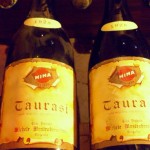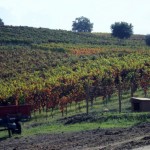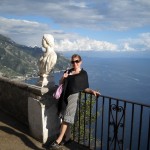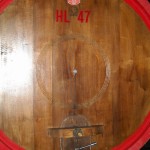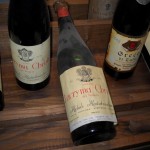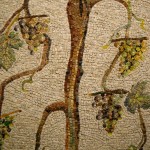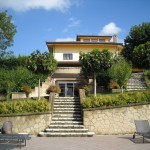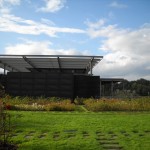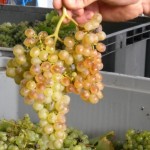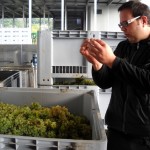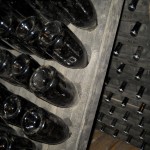The scent of freshly fermenting grapes pervaded the air. We had arrived in Avellino early on a Saturday morning and were warmly welcomed by Eliana at Mastroberardino. Harvest had just begun and things were in full swing at the winery.
Eliana showed us through the cellars where we admired large botti maturing the next generation of Taurasi. These oak vessels are much larger than the typical barrel (225 l) and impart less wood influence on the finished wine due to the limited surface area compared to the voume of wine.
Almost more art gallery than aging room, the ceilings of the cellars are adorned with beautiful frescos commissioned by Mastroberardino to depict wine-related scenes such as the marriage of Bacchus. After this tour, we watched a brief video on the winery and its history, and then Eliana brought us to the wine cellar. Again, artistic elements decorated the room, which housed old bottles of Mastroberardino wines, including bottles from 1928.
We paused to admire current bottles for sale in the winery’s retail shop before heading to Mastroberardino’s resort, Mirabella, about 30 minutes away.
Following Eliana’s Fiat in our own car, we drove through small towns and took in the view of vineyards we passed along the way. Here, we noted interesting trellising techniques with the vines trained very high.
As we pulled into Mirabella, we saw the lovely facade of the main building, but continued to drive a bit further onto the property so that we could view the vineyards, golf course — a tournament was underway during our visit, and pool house.
Reluctantly, we willed ourselves away from the staggering beauty of the hillside vines, and headed in to lunch in the main dining room. We were treated to a multi-course meal, paired with the exquisite Mastroberardino wines. Each delicious course was joined with at least one wine, all of which complemented the food. Finally, we enjoyed a few last bites of dessert and then espresso before saying our goodbyes and thank yous to Eliana.
Our next stop was Feudi di San Gregorio, which is situated in the opposite direction, near Irpina. Upon our arrival at Feudi, we were greeted by Emanuela who served as our guide for the remainder of the day.
The on-again, off-again rain let up just enough to permit us to wander through the hanging gardens before we walked over to the crush pad. A new load of grapes had just arrived and the lugs were being lifted off the truck, setting things in motion.
The tour of Feudi’s cellars included views of their pupitres (riddling racks), botti, barrels and a special creche. We were briefly permitted to enter the actual winery, but the winemaker quickly shooed us out for fear that we might be overcome by the carbon dioxide seeping from the fermentation tanks.
Emanuela then brought us to a modern part of the winery, which housed its retail/wine bar area and a place for us to sit and taste their wines. We started with their sparkling wines, which were really lovely. Unfortunately, these wines are not exported to the U.S., so you’re restricted to enjoying them in Italy (although there are worse places to be restricted to be). The tasting continued with Feudi’s still wines.
Overall, the tastings provided strong evidence as to why these two wineries are so highly regarded. Standouts at Mastroberadino included the Falanghina, showing mineral, herbal and citrus notes on both the nose and palate, and the Radici Taurasi Riserva 2004, which displayed perfume, oak, vanilla, smoke, berries and other dark fruit flavors. My favorites at Feudi were its full-bodied Cutizzi Greco di Tufo with stone, spice and apple aromas and the Piano di Montevergine Taurasi Riserva 2002 with floral, black fruit, licorice and long length.

